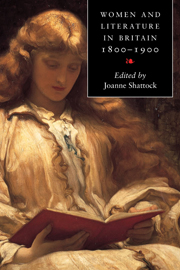Book contents
- Frontmatter
- Contents
- List of contributors
- Acknowledgments
- Chronology
- Introduction
- 1 The construction of the woman writer
- 2 Remaking the canon
- 3 Women and the consumption of print
- 4 Women writing woman: nineteenth-century representations of gender and sexuality
- 5 Feminism, journalism and public debate
- 6 Women's writing and the domestic sphere
- 7 Women, fiction and the marketplace
- 8 Women poets and the challenge of genre
- 9 Women and the theatre
- 10 Women writers and self-writing
- 11 The professionalization of women's writing: extending the canon
- 12 Women writers and religion
- 13 Women writing for children
- Guide to further reading
- Index
10 - Women writers and self-writing
Published online by Cambridge University Press: 03 October 2009
- Frontmatter
- Contents
- List of contributors
- Acknowledgments
- Chronology
- Introduction
- 1 The construction of the woman writer
- 2 Remaking the canon
- 3 Women and the consumption of print
- 4 Women writing woman: nineteenth-century representations of gender and sexuality
- 5 Feminism, journalism and public debate
- 6 Women's writing and the domestic sphere
- 7 Women, fiction and the marketplace
- 8 Women poets and the challenge of genre
- 9 Women and the theatre
- 10 Women writers and self-writing
- 11 The professionalization of women's writing: extending the canon
- 12 Women writers and religion
- 13 Women writing for children
- Guide to further reading
- Index
Summary
In 1826 the publishers John Hunt and Cowden Clarke advertised a series on life writing provocatively entitled Autobiography: a Collection of the Most Instructive and Amusing Lives Ever Published, Written by the Parties Themselves. In their initial ‘Advertisement’ they featured no women's self-writing; their list of forthcoming volumes included only men's accounts, classified not by genre or mode but by the writers' public roles: statesmen (Sully, Bubb Doddington), men of genius and literature (Gibbon, Hume, Marmontel), religious enthusiasts (John Wesley, George Whitfield), artists (Benvenuto Cellini), dramatists and players (Colly Cibber, Carlo Goldini), mystics and impostors (William Lilly, James Hardy Vaux). Within a year, however, for reasons unknown, Hunt and Clarke had decided to include two examples of women's autobiography: the scandalous memoirs of Mary Robinson, an actress known in the late eighteenth century as the mistress of the Prince of Wales, later as a Romantic poetess, and the Life of Charlotte Charke, a picaresque narrative by the daughter of Colley Cibber, famous in her day for her cross-dressing onstage and off.
From our vantage point almost two centuries later, we might wonder why these early nineteenth-century publishers took so narrow a view of women's self-writing – narrow both in the sense that they published so little of it and in that they chose only one subgenre, the chroniques scandaleuses.
- Type
- Chapter
- Information
- Women and Literature in Britain 1800–1900 , pp. 209 - 230Publisher: Cambridge University PressPrint publication year: 2001
- 1
- Cited by



